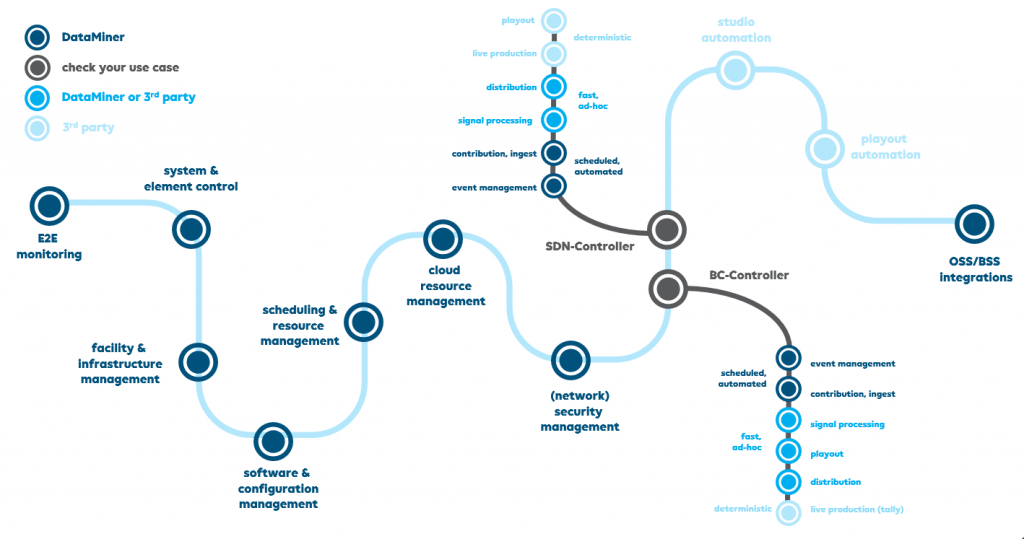Welcome to the final part of our blog series on orchestration and control. So far, we’ve taken a look at the roles of the different controllers in the broadcast industry, i.e. broadcast, network and SDN-controllers, and we’ve dug a little deeper into what differentiates an orchestration platform from a controller. Remember, orchestration is more than just switching signals, and what is more, orchestration comes with a time dimension to manage your signals, services, productions and events from all angles.
Just think of the four building blocks of a service orchestration platform: Onboard, Plan, Control, Monitor. Everything related to onboarding, planning and monitoring is a perfect fit for DataMiner. When it comes to control, you have the choice. There are use cases where DataMiner will take the role of a broadcast or SDN-controller, or both, and there are also projects where an integration of the DataMiner orchestration platform with a third-party controller might be a better fit.
The image below shows a high-level overview:

DataMiner as SDN-controller
Scheduled and automated signal switching
DataMiner is your SDN-controller and service orchestrator of choice when connections are planned up front in an automated and scheduled manner. DataMiner supports any network architecture (e.g. monolithic, spine-leaf, multi-site networks, etc.), works in blocking and non-blocking infrastructures, and supports destination-based, switch-based and even source-based switching with switches and media edge devices from any vendor. When the time to set up a connection is less relevant, DataMiner is your SDN-controller and service orchestration platform with full resource and network capacity management.
Fast & ad-hoc switching
When you need support for fast and ad-hoc signal switching, DataMiner is again the perfect choice for your SDN-controller for a non-blocking (IGMP) network, i.e. a network where no network capacity management is required.
When your blocking network architecture is managed by a third-party network controller that brings bandwidth awareness to IGMP and PIM, for example Cisco IPFM, which comes with NBM (non-blocking multicast), or Arista MCS (media control services), a DataMiner SDN-controller on top of the network controller will allow fast and ad-hoc switching as well.
For blocking network infrastructures, where network capacity management is a must to prevent link oversubscription, a DataMiner SDN solution (without any third-party network controller) will need more time to calculate and configure the flow path. Depending on the switching mechanism and responsiveness of the network infrastructure, more or less time (ranging from multiple frames up to seconds) may be needed to establish the connection between a source and destination with DataMiner.
Deterministic and frame-accurate switching
Deterministic and frame-accurate switching, mainly needed in combination with playout automation systems, implies that the time it takes to change from one flow to another is always the same under any circumstances. In this case, our current recommendation is to use a third-party SDN-controller.
By the way, don’t mix this up with technical clean (“break before make”) or visual and noiseless clean (“make before break”) switching. The latter is a functionality provided by the receiver in combination with destination-based switching, not by the SDN-controller. Switching a signal can be done clean and fast, but is not necessarily frame-accurate. And one more note: clean switching can typically not be achieved with off-the-shelf switches and switch-based switching.
For more information, have a look at our recent white paper Software-defined networking for media explained.
DataMiner as broadcast controller
Signal switching & management
DataMiner has everything you need for the front end for any kind of signal routing. The platform comes with highly customizable software routing panels with label, UMD and virtual signal group management for manual ad-hoc operations. With the DataMiner V-Matrix, multiple physical routers can be combined and managed in a single virtual matrix. With just one click, an operator can make a connection across several legacy SDI routers and your new all-IP SDN infrastructure. DataMiner not only acts as SDN-controller but also manages your SDI tie-lines.
DataMiner also comes with specialized user interfaces to schedule connections up front, such as wizards and timeline views, and takes work orders that include the required signals from external scheduling systems.
What about hardware control panels? Skyline Communications is an ICT company and does not produce hardware control panels. However, third-party control panels can be attached to DataMiner. There are programmable panels available on the market, for example the new Riedel Smart Panels or panels from Densitron, which can act as a remote interface for DataMiner. This includes setting a crosspoint, but also real-time parameter control.
Whenever you want to reuse your broadcast controller or router control system together with existing hardware router panels, you can feel free to do so. DataMiner can act as the router to your broadcast controller, emulating a common northbound routing protocol.
Parameter control
Another typical use case is real-time ad-hoc parameter control for your equipment. Both DataMiner’s highly customizable Visio-based visual overviews and our new HTML5 dashboards can give you the right interface to control your equipment in real time.
Tally management
For live productions which require tally, DataMiner typically interfaces with a third-party tally controller or with a broadcast controller that comes with built-in tally management.
Conclusion
In conclusion, every project and deployment is different. When you think of orchestration, don’t mix it up with SDN control. A service orchestration platform covers much more than that. ONBOARD, PLAN, CONTROL & MONITOR: those are your four pillars. You might find that DataMiner is the right platform to fulfill your goals and objectives for each building block. In case you go for a third-party solution for SDN and broadcast control, this is perfectly fine as well. It all depends on your needs and underlying infrastructure.
If you’d like to know more to define the right solution for your specific project, feel free to reach out to our team. We’ll be more than happy to help you!